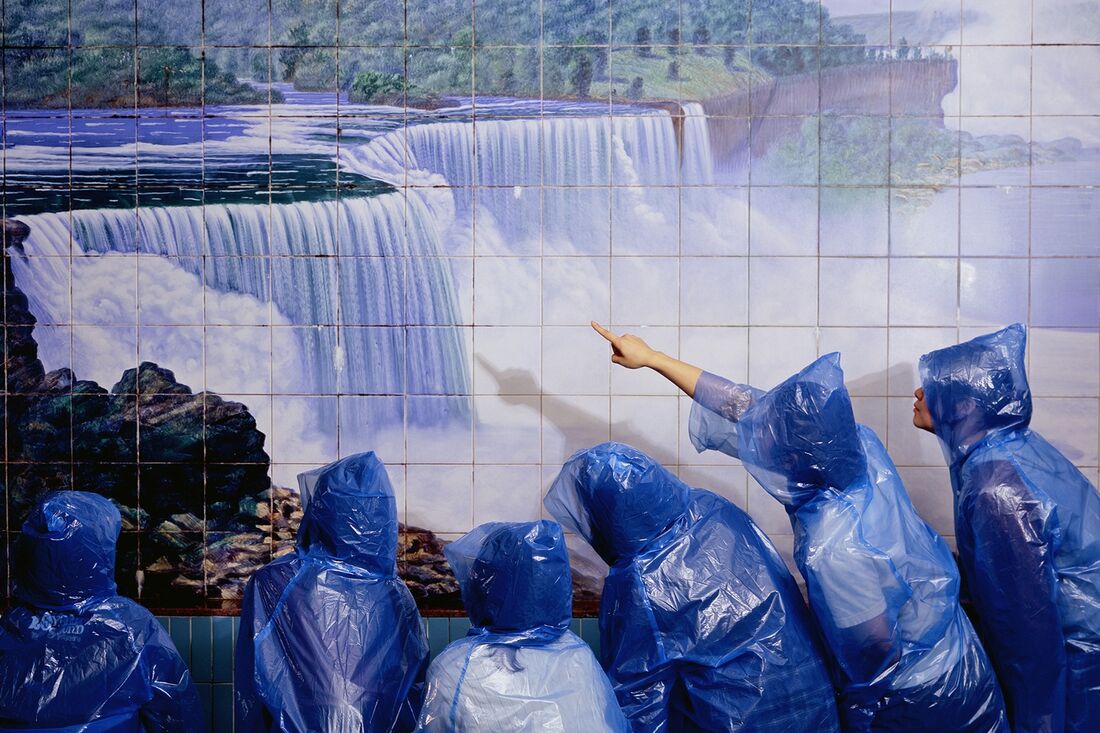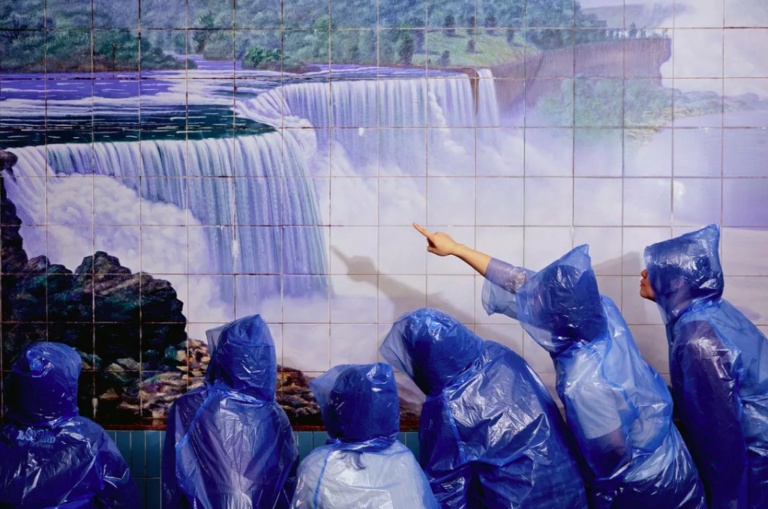
This article was produced in collaboration with the Korea Arts Management Service (KAMS).
Falling cherry blossoms, a field of flowers, a rising tide, a Zen garden—these might seem like candidates for a screen saver or default phone background, but they’re also intentionally cliché subjects from some of Jaye Rhee’s early-’00s videos. 2000s. In statements and interviews from that time, Rhee often expressed an interest in the idea of the “fake.” She would create a scene that resembled those images using an excess of common materials, including chewing gum, plywood, chalk, thread, and dust eraser. (Several of these pieces were included in his first US solo show, “Real Fake” at the Chicago Cultural Center, held in 2004 after completing his MFA at the School of the Art Institute of Chicago.)
By creating these general impressions of stereotypically beautiful scenes from obviously cheap materials, Rhee says she hopes to explore the question, “What’s behind what I’m looking at?” In an interview with Artsy, he pointed to koans, phrases that are thought of repeatedly in meditation, just as a clichéd image is presented over and over again. In his view, by dwelling on these images, we might come to some kind of enlightened understanding.
Rhee was investigating these ideas during the early years of widespread internet adoption, a period that is key to Hito Steyerl’s 2009 essay “In Defense of the Poor Image,” about the proliferation of the “bad” deteriorated image online. Recycled and pirated images, he writes, could evade privatization attempts and create alternative distribution networks. For Steyerl, the flattened image is more real than the seductive, high-resolution one: “Of course, one can argue that this is not the real thing, but then, please, anyone, show me this real thing. The poor image is no longer about of the real—the original original. Instead, it is about its own real conditions of existence.”
Similarly, Rhee’s recreations of images are less about an “original” image of cherry blossoms falling to the ground than about the creation of the cliché. In the 2003 video cherry blossoms, the artist, off-screen, throws chewed pink gum on the floor, until pink clumps begin to cover the floor. The video is edited to speed up the process into something like a time lapse. When installed, the video is displayed on multiple screens that further reproduce the images. (The soundtrack is a slower revelation: as Carol Becker wrote, it initially recalls the plucking of a Chinese zither, but is actually a slow-motion recording of the artist moving her hand through a box of packed peanuts.)
Something changed in Rhee’s work in 2007, as she planned a trio of video pieces titled swan, Polar beare niagara, filmed in a Korean bathhouse whose tiled walls have been painted with the titular themes. In swan e Polar bear, a static shot focuses on a patch of bath water and the mural behind it as Rhee slowly swims back and forth across the pool, sometimes creating the illusion of being immersed in the same landscape as those creatures. In niagaraRhee worked with actors, dressed in cheap plastic bag raincoats, who huddle together and excitedly point to the mural of the waterfall as if they were in the actual tourist spot.
Since the owners of the bathhouse repeatedly refused to let her shoot these videos, Rhee entered the space courtesy of an employee who cleaned the bathhouse monthly and had listened to her request. She came to recognize that relationships behind his work was determining its form and possibility, and he became increasingly interested in allowing such encounters to guide his practice.
That project led Rhee to research other characters in the history of art and visual culture: in addition to “the bather,” he highlighted “the dancer” as well as “the cowboy.” In the process of developing this ongoing body of video work, Rhee builds relationships with people who embody those roles. Then, in the short videos Rhee makes of those people, the actors or performers often appear as generalizations of their “type.” For example, your black and white multichannel videos notes (2007-2008) and The meat and the book (2013) are set in sparse white space with five long elastic bands running horizontally across the frame: a visualization of a musical staff. Within this space, a group of dancers dressed in black perform movements that could be associated with modern dance, such as jumping, crouching, lifting one leg at a time, reaching a tilted pose. The effect is easy to read: these performers assume the musical notes arranged on the spatialized staff and interpret the score with their bodies.
In fact, the performers in The meat and the book they were actually dancers from the Merce Cunningham Dance Company, which disbanded before Rhee shot this piece. Although the performers seem to represent music and dance in a general sense, their individualized movements and shared history with the same company and tradition of modern dance bring a level of specificity to the work.
This contrast between the performers’ lived and on-screen experience is highlighted in the two-channel color video The Perfect Moment (2015). Here, an unnamed woman describes in detail various moments in her life as a young choreographer in New York. She focuses on two performances, one by a famous modern dancer and one she did herself. Describing her own choreography, she pauses in a pose she says she could stay in forever. The first channel of The Perfect Moment it focuses on the choreographer from the shoulders up as she relays her experiences in a seemingly heartfelt, unscripted monologue. The second channel shows a younger dancer in another part of the same loft space performing what may or may not be the same gestures as the choreographer explains.
Rhee asked this younger dancer to perform based only on the script of the older woman’s descriptions; the two subjects have not discussed the movements and the channels are not synchronized to match. For Rhee, the interesting thing here is the translation, the attempt to remember, then articulate and then embody something in the past. As a recording of a recording posted online and streamed in low resolution, The Perfect Moment it’s quite far from that actual moment of mid-dance delight, but it’s about how that moment can continue in other altered forms.
Recently, Rhee has moved away from video towards acting itself. As part of his ongoing project “Far West, So Close”, he presented a performance and sound work entitled Arizona Cowboy at the 12th Seoul Mediacity Biennial and a group exhibition at MCA Denver. Rhee explores the trope of the American cowboy and its global export, based on his personal experience of fantasy. When Rhee was growing up in South Korea, for example, she had a skirt made of a fabric printed with pictures of cacti under a blue sky and heard a 1955 song called “Arizona Cowboy,” one of several Korean pop songs from that decade that was based on a imagined American culture. “The song doesn’t speak directly to images of Arizona,” Rhee wrote in a project proposal, “but instead draws on clichéd images of the ‘American West’ like a spaghetti western. Influenced by the remnants of the US military in South Korea, the lyrics spoke of Koreans’ desire to return “home,” a desire shaped by displacement.
In Rhee’s 2023 performance at the Seoul Museum of Art, this song was rearranged as a Gregorian chant and sung by a small choir. The melody is recognizable as the pop song at first, but in a haunting register. Rhee specifically chose singers who are relative “foreigners”; they did not grow up in South Korea but moved there for vocal training. The performance seems sad, perhaps especially to visitors who do not know the original song. Nearly seventy years after the source song was written, the figure of the cowboy might seem antiquated as an American icon, but his cousins—the pioneer, the entrepreneur, and the settler—are as alive as ever, with obvious consequences. If Rhee’s cover of “Arizona Cowboy” evokes a sense of loss, then the allusion is not to the loss of an original figure, the “real” cowboy, but to the losses these figures have caused. In other words, his work conjures all those who struggle in the shadow of the cowboy.

